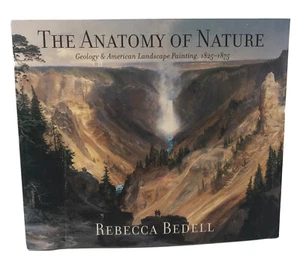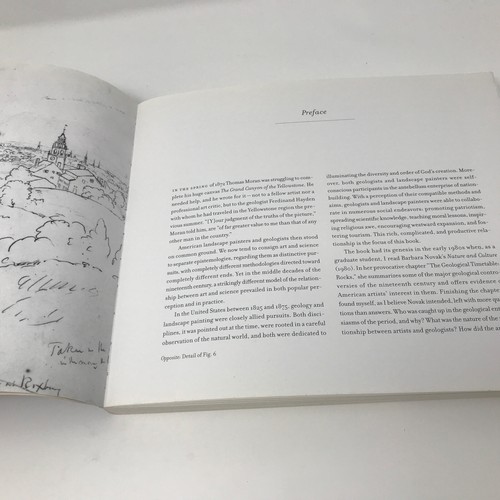Picture 1 of 12












Gallery
Picture 1 of 12












Have one to sell?
The Anatomy of Nature: Geology & American Landscape Painting, 1825-1875: Fine
US $28.50
ApproximatelyRM 120.36
Condition:
“Very Good, almost Like New softcover. Clean, tight, one of the half title pages has a small blemish ”... Read moreabout condition
Very Good
A book that has been read but is in excellent condition. No obvious damage to the cover, with the dust jacket included for hard covers. No missing or damaged pages, no creases or tears, and no underlining/highlighting of text or writing in the margins. May be very minimal identifying marks on the inside cover. Very minimal wear and tear.
Oops! Looks like we're having trouble connecting to our server.
Refresh your browser window to try again.
Shipping:
US $5.97 (approx RM 25.21) USPS Media MailTM.
Located in: Boston, Massachusetts, United States
Delivery:
Estimated between Thu, 16 Oct and Mon, 20 Oct to 94104
Returns:
60 days return. Buyer pays for return shipping. If you use an eBay shipping label, it will be deducted from your refund amount.
Coverage:
Read item description or contact seller for details. See all detailsSee all details on coverage
(Not eligible for eBay purchase protection programmes)
Seller assumes all responsibility for this listing.
eBay item number:157383996619
Item specifics
- Condition
- Very Good
- Seller Notes
- Pages
- 185
- Publication Date
- 2002-06-23
- Custom Bundle
- No
- Educational Level
- Art School, Adult & Further Education, Vocational School
- Personalized
- No
- Features
- Illustrated
- Level
- Beginner, Intermediate, Advanced, Technical
- Country/Region of Manufacture
- Hong Kong
- ISBN
- 9780691102917
About this product
Product Identifiers
Publisher
Princeton University Press
ISBN-10
0691102910
ISBN-13
9780691102917
eBay Product ID (ePID)
2357798
Product Key Features
Number of Pages
200 Pages
Language
English
Publication Name
Anatomy of Nature : Geology and American Landscape Painting, 1825-1875
Publication Year
2002
Subject
American / General, History / General
Type
Textbook
Subject Area
Art
Format
Trade Paperback
Dimensions
Item Height
0.8 in
Item Weight
37.6 Oz
Item Length
8.9 in
Item Width
10.3 in
Additional Product Features
Intended Audience
College Audience
TitleLeading
The
Reviews
"In this wonderfully written, scholarly, and handsomely illustrated work, Bedell examines the fascinating and often surprising intersection of the two disciplines in the nineteenth century."-- Ann Finholt, Ruminator Review, In this wonderfully written, scholarly, and handsomely illustrated work, Bedell examines the fascinating and often surprising intersection of the two disciplines in the nineteenth century., "In her scholarly, yet eminently readable and amply illustrated treatise . . . Rebecca Bedell paints us a detailed picture of how the 19th century's 'fashionable science' molded . . . Art. . . . Seldom has the union of the arts and sciences come to such good effect."-- American Scientist, In this wide ranging book, Rebecca Bedell looks beyond the usual labels . . . to find an unexpected continuity in 19th century American landscape painting: its obsession with the once fashionable science of geology. In lucid prose free of academic jargon, Bedell surveys the intersection of art, tourism and geology in the work of such painters as Thomas Cole, John Kensett and Thomas Moran., In this wonderfully written, scholarly, and handsomely illustrated work, Bedell examines the fascinating and often surprising intersection of the two disciplines in the nineteenth century. -- Ann Finholt, Ruminator Review, "In this wide ranging book, Rebecca Bedell looks beyond the usual labels . . . to find an unexpected continuity in 19th century American landscape painting: its obsession with the once fashionable science of geology. In lucid prose free of academic jargon, Bedell surveys the intersection of art, tourism and geology in the work of such painters as Thomas Cole, John Kensett and Thomas Moran." -- New York Times Book Review, "In this wide ranging book, Rebecca Bedell looks beyond the usual labels . . . to find an unexpected continuity in 19th century American landscape painting: its obsession with the once fashionable science of geology. In lucid prose free of academic jargon, Bedell surveys the intersection of art, tourism and geology in the work of such painters as Thomas Cole, John Kensett and Thomas Moran."-- New York Times Book Review, "In her scholarly, yet eminently readable and amply illustrated treatise . . . Rebecca Bedell paints us a detailed picture of how the 19th century's 'fashionable science' molded . . . Art. . . . Seldom has the union of the arts and sciences come to such good effect." -- American Scientist, In her scholarly, yet eminently readable and amply illustrated treatise . . . Rebecca Bedell paints us a detailed picture of how the 19th century's 'fashionable science' molded . . . Art. . . . Seldom has the union of the arts and sciences come to such good effect., "In this wonderfully written, scholarly, and handsomely illustrated work, Bedell examines the fascinating and often surprising intersection of the two disciplines in the nineteenth century." --Ann Finholt, Ruminator Review, In this wide ranging book, Rebecca Bedell looks beyond the usual labels . . . to find an unexpected continuity in 19th century American landscape painting: its obsession with the once fashionable science of geology. In lucid prose free of academic jargon, Bedell surveys the intersection of art, tourism and geology in the work of such painters as Thomas Cole, John Kensett and Thomas Moran. -- New York Times Book Review, Winner of the 2002 New York Book Show Award Winner of the 2001 Award for Best Professional/Scholarly Book, Association of American Publishers, In her scholarly, yet eminently readable and amply illustrated treatise . . . Rebecca Bedell paints us a detailed picture of how the 19th century's 'fashionable science' molded . . . Art. . . . Seldom has the union of the arts and sciences come to such good effect. -- American Scientist
Dewey Edition
21
Illustrated
Yes
Dewey Decimal
758/.1/097309034
Table Of Content
Preface ix Acknowledgments xii Intoduction: The Popularity of Geology 3 Chapter One: Thomas Cole and the Fashionable Science 17 Chapter Two: Asher Durand and the Therapeutic Landscape 47 Chapter Three: Frederic Church and the Educational Enterprise 67 Chapter Four: John Kensett, Geology, and Landscape Tourism 85 Chapter Five: William Stanley Haseltine and the Rocks at Nahant 109 Chapter Six: Thomas Moran and the Western Surveys 123 Conclusion 147 Notes 153 Selected Bibliography 171 Index 180
Synopsis
Geology was in vogue in nineteenth-century America. People crowded lecture halls to hear geologists speak, and parlor mineral cabinets signaled social respectability and intellectual engagement. This was also the heyday of the Hudson River School, and many prominent landscape painters avidly studied geology. Thomas Cole, Asher Durand, Frederic Church, John F. Kensett, William Stanley Haseltine, Thomas Moran, and other artists read scientific texts, participated in geological surveys, and carried rock hammers into the field to collect fossils and mineral specimens. As they crafted their paintings, these artists drew on their geological knowledge to shape new vocabularies of landscape elements resonant with moral, spiritual, and intellectual ideas. Rebecca Bedell contributes to current debates about the relationship among art, science, and religion by exploring this phenomenon. She shows that at a time when many geologists sought to disentangle their science from religion, American artists generally sidestepped the era's more materialist science, particularly Darwinism. They favored a conservative, Christianized geology that promoted scientific study as a way to understand God. Their art was both shaped by and sought to preserve this threatened version of the science. And, through their art, they advanced consequential social developments, including westward expansion, scenic tourism, the emergence of a therapeutic culture, and the creation of a coherent and cohesive national identity. This major study of the Hudson River School offers an unprecedented account of the role of geology in nineteenth-century landscape painting. It yields fresh insights into some of the most influential works of American art and enriches our understanding of the relationship between art and nature, and between science and religion, in the nineteenth century. It will draw a broad audience of art historians, Americanists, historians of science, and readers interested in the American natural landscape., An illuminating account of the interplay between science, religion, and nature in nineteenth-century landscape painting Geology was in vogue in nineteenth-century America. People crowded lecture halls to hear geologists speak, and parlor mineral cabinets signaled social respectability and intellectual engagement. This was also the heyday of the Hudson River School, and many prominent landscape painters avidly studied geology. Thomas Cole, Asher Durand, Frederic Church, John F. Kensett, William Stanley Haseltine, Thomas Moran, and other artists read scientific texts, participated in geological surveys, and carried rock hammers into the field to collect fossils and mineral specimens. As they crafted their paintings, these artists drew on their geological knowledge to shape new vocabularies of landscape elements resonant with moral, spiritual, and intellectual ideas. Rebecca Bedell contributes to current debates about the relationship among art, science, and religion by exploring this phenomenon. She shows that at a time when many geologists sought to disentangle their science from religion, American artists generally sidestepped the era's more materialist science, particularly Darwinism. They favored a conservative, Christianized geology that promoted scientific study as a way to understand God. Their art was both shaped by and sought to preserve this threatened version of the science. And, through their art, they advanced consequential social developments, including westward expansion, scenic tourism, the emergence of a therapeutic culture, and the creation of a coherent and cohesive national identity. This major study of the Hudson River School offers an unprecedented account of the role of geology in nineteenth-century landscape painting. It yields fresh insights into some of the most influential works of American art and enriches our understanding of the relationship between art and nature, and between science and religion, in the nineteenth century. It will draw a broad audience of art historians, Americanists, historians of science, and readers interested in the American natural landscape.
LC Classification Number
ND1351.5.B43 2002
Item description from the seller
Seller feedback (393)
- Automatyczna opinia eBay- Feedback left by buyer.Past monthZamówienie zostało dostarczone na czas bez problemów
- m***m (455)- Feedback left by buyer.Past monthVerified purchaseGreat, thank you. Andy
- Automatyczna opinia eBay- Feedback left by buyer.Past monthZamówienie zostało dostarczone na czas bez problemów
More to explore :
- Geology Outdoor & Nature Antiquarian & Collectible Books,
- North American Geology Antiquarian & Collectible Books,
- Illustrated Geology North American Antiquarian & Collectible Books,
- Geology North American Hardcover Antiquarian & Collectible Books,
- Geology Outdoor & Nature Hardcover Antiquarian & Collectible Books,
- Geology Illustrated Outdoor & Nature Antiquarian & Collectible Books,
- Geology Textbooks,
- Anatomy Textbooks,
- Anatomy Hardcover Textbooks,
- Geology Original Antiquarian & Collectible Books